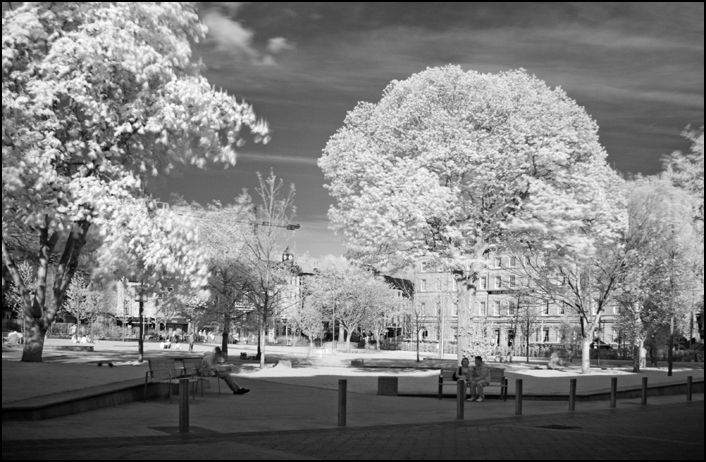May 30, 2006
250% Proof

Plants under plastic beside the Dublin Rd. near Oranmore, Co. Galway. I'm not sure whether it is maize or leeks under the plastic. As long as it's not asparagus - I really hate asparagus.
According to Met Eireann this evening, Connacht had 250% more rain than normal this May. And tonight, there will be frost in the midlands (my mother has just taken all her flowers out of the glasshouse to harden them up this week - they'll be as hard as popsicles by morning). I think I might put off buying the barbecue for another week...
Camera = Canon 5D , lens = Canon 24-105mm@105mm, ISO=320,Aperture=f11,speed=1/30 sec.
May,ireland, irishblogs,photoblogs,monasette,galway,orannmore.
The Cold Equations

The stretch of waste ground between Rinnmore Point (at Galway Harbour) and Renmore Barracks forms a varied wildlife habitat [it is the area on the other side of the rail track from Lough Atalia]. There is a small marsh, that supports mute swans , ducks, herons and lots of snipe*. There is a small meadow habitat formed by the grassy ridge that separates the marsh from the sea, and the outer boundary of the habitat is bounded by the small sheltered beach.
Strolling along there in the evening sun this week, something small rustled at my feet before disappearing into the grass. I couldn't see what it was - I presumed it was a mouse or rat. The second time it happened, I was closer to the shore and I spotted the culprit. It was a young meadow pipit, probably 4 to 6 weeks old.
I find it hard to differentiate between meadow pipits (Anthus pratensis) and rock pipits (Anthus spinoletta) but I think this was a meadow pipit judging by the habit of the adults to fly high into the air singing (just like skylarks but the pipit song seems less melodious) before plummeting to earth to take up a singing position on a shrub or other vantage point.
The young pipit was tiny (it could have easily sat in a desert spoon, and appears bigger on screen than in reality), and probably not able to fly very far). When it settled on the rock, it stayed perfectly still - the only means of defence available to it. I approached it slowly. At one point, it gave a short jolt, like a sprinter making a false start , before freezing again. At the same time, a couple of adults took up positions on rocks nearby and chirped as loudly as possible, attempting to distract me.
I didn't get too close (the lens won't focus closer than two metres anyway). I got my shot and edged back. The little bird never moved all the time I was in sight, as I strolled back down the beach. For the adult pipits, it is a simple calculation. Make some noise, and if that doesn't work, so be it. They'll lay more eggs this year, and their only purpose in life is to survive until next year to lay yet more eggs. For the little one, it's manoeuvre might have outwitted one of the occasional dogs that are exercised along this secluded spot, but wouldn't have fooled a cat or fox for a second. To move or not to move ? It's a big decision for a small bundle of feathers. Move or stay ? Live or die. Simple as that.
Camera = Canon 5D , lens = Canon 100-400mm@400mm, ISO=400,Aperture=f14,speed=1/30 sec**, Spot-metered.
pipit,May,ireland, irishblogs,photoblogs,monasette,galway,renmore.
* The word sniper originated as denoting someone skilled enough to shoot a snipe. It's hard enough to spot one - they wait until you almost walk on them, then they explode from the undergrowth and zig-zag like mad as they fly away. I've never succeeded in photographing one on the fly - it would take Davy Crockett to hit one even with buckshot.
** For the photographers out there, you might be wondering which I used such a low shutter speed. The rule of thumb is that your shutter speed should be 1/focal length of the lens In this case, the focal length of the lens was 400mm so I should have been using a shutter speed of 1/400 sec. The reason that the picture isn't blurred is because the lens has Image Stabilization. That provides about 3 extra 'stops' of speed, which would mean that my effective shutterspeed was about 1/125 sec. That's still too slow. In fact, though the picture looks ok on the web, it isn't sharp enough to print up to 12X10. The truth is , I was concentrating so much on getting the shot that I didn't check the shutter speed (I was using Aperture Priority and previous shots had higher speeds). Must try harder next time.
May 28, 2006
The Awkward Squad

Last Saturday, I happened across the start of the Annual Afri Famine Walk along Doo Lough [which commemorates the walk made by hungry tenant famers along the lake during the Famine. They walked to the local 'Big House' to look for food - ironically, there was a Famine Relief meeting in progress attended by the local "Great and Good". the walkers were turned away and many of them dropped dead from exposure and hunger on the way home ]. This year, the focus was on Shell - one of the Rossport Five [Vincent McGrath] helped lead the walk, as did Christy Moore and Owens, the brother of Ken Saro Wiwa who was killed by his own government in Nigeria for protesting against oil company exploitation there.

There was a good turn out - about 300 people. What was less admirable was the habit of some of the marchers to obstruct the few cars (mainly tourists) from passing through. There weren't too many cars, and one tour bus, but walkers made sod-all effort to allow them through - in some cases, one or two persons would walk in the middle of the road holding up the cars even though it wouldn't take any effort (or slowed them down) to move to the side of the road.

I should point out that none of the leading group did this. It's shame to see that kind of behaviour - if I was leading a hike with people that indulged in that sort of behaviour, I'd send them home - maybe they thought we had Shell fuel in our cars.
All pics: Camera = Canon 5D , lens= Canon 24-105mm ISO=160, Aperture=f11.
famine,May,ireland, irishblogs,photoblogs,monasette,mayo,doolough.
My Blue Heaven

Two weeks ago, (after spotting some pictures on Flickr), Sean McCormack and I went over to Portumna Forest park to photograph the bluebells. Sean is this year's winner of the Galway Camera Club's Nortel Trophy - and congratulations again, Sean [and thanks again to Andrea, pj_poppy and Caitriona for helping me pick my entries].
Now, Sean's job as a sound engineer means he works late into the night, so it took real effort on his part to meet me at 07.30 am on the Saturday morning (actually, I don't think he had seen 07.30 before). By 8.30, we were walking along the Turlough walk in the park - at that hour of the morning, we had the place to ourselves. We saw plenty of fallow deer (if I'd been out trying to photograph them, there probably have been no sign of them). Bluebells, on the other hand, were in decidedly short supply. We walked and walked, but still couldn't find any. I was beginning to feel a bit bad for having dragged Sean into the wilderness at an ungodly hour ( he looked as if he was getting withdrawal symptoms ). We stopped in the magnificent stand of beech trees (worth a photo trip in itself), and I was sure that if the bluebells were anywhere, they would be there. They weren't.
My backup plan is always the same - wander about randomly in the hope of stumbling across what I was looking for), and yet again, the plan came up trumps. We turned a corner, and up ahead, glowed a oval hill of pure purple. It was a magnificent sight - a thick carpet of bluebells in a stand of hazel and young beech trees. We set to work. And that's when it occurred to me that maybe I was under just a little pressure to take a good shot.
Normally, I take photos on my own and the pictures that you see on the site are the ones that I think are the best. Plus, they are usually the only pictures of that particular spot at that particular time, so no-one knows if I could have done better. I can't blame my tools anymore. I'm using two Canon DSLRs, a selection of lens that cover all possible focal lengths and a sturdy tripod. So I have a bit of a confession to make. After an hour or two of snapping, I still didn't think that I had done justice to the scene. Don't get me wrong - even if I didn't have any cameras, it was a real privilege to see such a scene - impossibly beautiful and, on a Saturday morning, undisturbed by any other humans. But I don't think I got the best shot possible there that morning [I'm waiting to see Sean's pics].
Back at the car park, I got talking to ladies who were sharing a flask of tea. I asked them if they had walked through the woods. "Walk ? We're from Australia -we don't walk around places - we drive around them!" And the reason for their visit? "Over to meet the mad rellies", came the reply, though I suspect that the relatives probably refer to themselves somewhat differently.
Camera = Canon 350D , lens= Sigma 10-20mm@14mm, ISO=100,Aperture=f10,speed=1/6 sec.
bluebell,May,ireland, irishblogs,photoblogs,monasette,galway,portumna.
May 23, 2006
Downfall

Reedbed beside the dolmen at Srahwee, Co. Mayo, on Saturday.
The Irish Times carried an article today (based on this press release from the Heritage Council) about the list of species facing extinction in Ireland. It makes grim reading. The list is:-
the Pearl Mussel (apparently doomed in the 10-12 river habitats where it now resides), six species of Bumblebee, Green-Winged Orchid, Barn Owl, Golden Plover, Waxcap (type of toadstool), Marsh Fritillary Butterfly and the Corncrake.
As the Heritage Council point out, Pearl Mussels live to about 120 years, and the mature mussels alive today predate Irish Independence – the problem is that no new mussels are growing, due to pollution. I have to say that I’m a little shocked at the thought that bumblebees and golden plovers are endangered – plovers were a common sight when I was growing up, and there seemed to be no shortage of bumblebees when I was standing in a field of blossoms taking this photograph .
As for the corncrake, it never seems to get a break. On the same page in the paper, there was a story about how this May might be the wettest ever (admittedly, records only began in 1940). March and April have been dry, and the ground is hard, meaning that the heavy rain is causing floods and swelling rivers quickly. The Shannon Callows is in danger of flooding as a result, and this would be a disaster for the corncrake population there. The Callows is a flood plain stretching from Athlone (literally just south of the town bridge) via Clonmacnoise, Shannonbridge down to Banagher. Right now, the corncrakes have laid their eggs in the rich meadows that are covered in water during winter. If summer flooding occurs, those nests will be destroyed. [There is a chance that the birds would hatch a second brood, but that assumes that the adults live long enough. Deprived of their meadow habitat for even a few weeks, the number of adult birds could be depleted.]
There are other Corncrake strongholds, in Donegal and the Aran Islands, that should be unaffected by the rain. But the sooner the sun starts shining again, the better it is for our secretive and increasingly rare African visitor.
UPDATE: The Athlone Advertiser raises similar concerns in this article this week.
Camera = Canon 350D , lens= Sigma 10-20mm@10mm, ISO=100,Aperture=f11,speed=1/250 sec.
UPDATE: 25th May 2006.

This swan is sitting on an island that should be a hillock 200 metres from the waters edge downstream of Athlone. I suspect that a few swans nests were destroyed by the sudden flooding too. The forest of cranes in the background marks the site of a huge new development in the Athlone town centre - an extra million square feet of shopping space and 1000 new carparking spaces - the impact of all those cars squeezing through Athlone's medieval streets to get there should give people there something to whinge about for years to come.
Camera = Canon 5D , lens= Canon 100-400mm@100mm, ISO=320,Aperture=f9,speed=1/500 sec.
corncrake,May,ireland, irishblogs,photoblogs,monasette,galway.
May 21, 2006
Digital Infrared

Forthill Cemetery, Galway City.
I've been messing about with some infra-red photography in the last month or two. I had intended to hold off writing about it until I had more (ok, better) photos to show you, but it seems like every time I go out with the purpose of doing some IR shots, the weather doesn't cooperate (or I forget the filter). I'll say at the outset that all of the techniques and tips mentioned below were figured out by other people (and I've included some of the links below). The point of this post is to gather some of the links together (for my own benefit as much as yours) and also to give a little feedback on my own experiments with IR. By coincidence, since I started writing this, there has been a discussion on Flickr relating to some of these issues - if you're a beginner to digital infrared, it's a good place to learn things. As far as I know, there hasn't been a major discussion on digital IR at the Galway Camera Club, though I've seen a few pictures using some of these techniques in some of the presentations.
Experimenting with digital infra-red photography is as simple as placing a glass IR filter in front of the lens and clicking away. Ok, maybe not that simple, but a lot more straightforward than film infra-red photography. I use a Hoya R72 (for a lens with a 58mm width) which will cost you 37 pounds sterling with Jessops. Because the filter is almost black, you need to use a tripod; firstly, because it's likely that you'll need to use a low shutter speed, and secondly, if you're using a DSLR, you'll need to compose the picture without the filter and then fit it on before taking the shot.
Why use an IR filter at all ? For me, it adds a different dimension to black & white photography, though it's not something I'd use too often. The IR filter blocks most visible light, letting just infra-red light through. The effect is that blue skies appear black and green foliage appears white - I don't see it any differently than using red or green filters for 'ordinary' black and white work.
I've used the filter with three different Canon cameras with varying results. I first tried IR with a Canon G3, which is a digital compact camera. One of it's more useful features is its LCD screen which gives a preview of the image. This is great for IR since you can actually preview the IR image. Alas, the results were not encouraging - the photos were very grainy and often lacked sharpness (like this one of a holy well in Inishmicatreer, which is just awful). The worst problem was the appearance of a 'hotspot' (I.e. almost burned out dot) in the middle of the image.
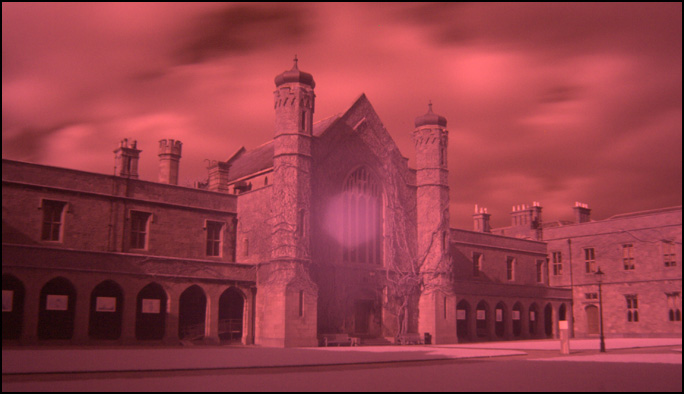
This is a typical example, taken in the 'Quad' in NUIG [This is the 'raw' image before any processing, showing the deep red tint caused by the filter]. It didn't happen in every photo (this one of Annaghdown turned out OK), but a lot of them. This appears to be a characteristic of the lens, and with a digital compact, you're stuck, since you cannot change the lens.
Since the IR filter is almost opaque, very little light of any sort gets through. This means that either you must use a very high ISO setting (which leads to increased graininess) or very slow shutter speeds. My G3 has many great qualities but producing sharp pictures at the highest ISO setting isn’t one of them. Even on a really bright sunny day (best conditions for IR photography), I would usually need to shoot 8-15 sec exposures – this limitation generally forces one to shoot landscapes (and preferably on a day when the wind isn’t blowing). Sunny, windless days in Galway ? Now you know why I don’t get to take IR photographs too often.
Digital cameras are fitted with internal filters to reduce infrared light. It's possible to get them removed - see here and here (though it means that your camera is only suitable for IR photography). Digital compacts seem to be a favourite for IR conversions - mainly because their owners have now graduated to DSLRs and don't mind sacrificing their old cameras. Despite my own lacklustre efforts, pictures on Flickr show that it is possible to get very good results with a G series camera.
A digital SLR has interchangeable lens, so I was eager to try out my IR filter when I bought my 350D. Unfortunately, the kit lens (18-55mm) that is supplied with the 350D also suffers from the hotspot problem. However, the Canon 75-300mm lens does not, and takes perfectly acceptable IR photos (including this one and also the shot below of Menlo Castle.
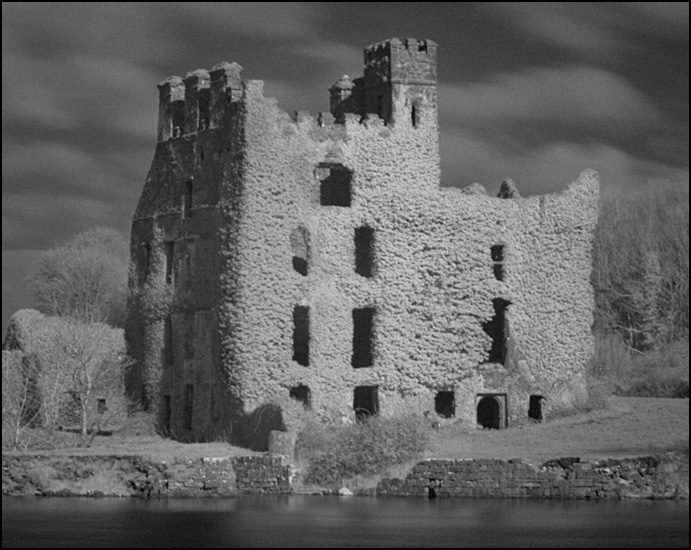 ">
">However, a telephoto zoom is not the best lens for landscapes. I also have a wide-angle zoom (the Sigma 10-20 mm) – but it has a 77mm thread and I didn’t feel like shelling out for a second filter. [I did test the lens to see if it suffered from a hotspot by taking the circular lid of a plastic container, cutting a 58mm hole in it and, using loads of gaffer tape, fixing the IR filter in the middle of it. From what I could see, the Sigma doesn’t suffer from a hotspot. And yes, that 'adaptation' was every bit as brutal and crude as it sounds].
I recently bought a EOS 5D – unfortunately, the lenses that I normally use with it (24-105mm and 100-400) have 77mm thread. But my old [film] EOS has two [fairly cheap] Sigma lenses – a 28-105 and a 70-300. These lenses don't work on my EOS350D but they do work on the 5D. And they don’t have hotspots either! The 5D has another advantage too – the images that it produces at high ISO are damn near faultless [what I mean is that they are sharp and grain-free – rubbish compositions are still my responsibility!]. Since I can use up to ISO 1000, it means I can set a relatively high aperture (say, f11) and still keep a reasonable exposure time (say 6 – 10 seconds). The longer the exposure time, the more likely it is that more of the image will be blurred. [Taking photos in Eyre Square, the biggest problem were those poxy crows that ruined about half the shots by swooping into view – you’d swear they were doing it deliberately]. Because of the high quality of images taken at high ISO, it would be possible to take photographs at relatively high shutter speeds (i.e. 1/30th of a sec) using a fast aperture. I don't have any examples of this here.
If you use normal metering, the photos tend to have a strong magenta tint. To avoid this, you should set a Custom White Balance. Most cameras allow you to adjust the White Balance on images. There are usually settings for fluorescent and tungsten lighting and it's also possible to set a custom function (even my G3 compact can store two separate custom settings). I must confess that I didn’t pay too much attention to this function until I saw how other IR photographers had used it - the main reason I don't use it is that I usually forget to turn it off afterwards. Setting a Custom White Balance (CWB) for IR can be done by pointing the camera with the IR filter at some grass (ideally, you'd use an 18% grey card or something else that's reflects an 'average' exposure) and taking a shot. On Canon cameras, there's a menu option to select that picture that acts as your CWB. On subsequent photos, this shot will be used by the camera to determine the black, white and grey levels in the shot. As you can see, the resulting picture is visually pleasing even without adjustment in Photoshop.
Of course, it's one thing to take a photograph, and another to produce a finished image in Photoshop. There are plenty of sources of techniques and pictures on the Web. As I mentioned before, the Flickr digital infrared discussion group (and there are plenty of pictures to look at) - it's a good starting point.
If you Google for digital infrared photography, you'll get a bunch of useful links that describe basic processing techniques. Sites such as Infrared photography with a digital camera , Shooting Infrared with Digital Cameras and Digital IR Choices are a good start. Prior to getting the 5D, I would convert the IR image to black and white (by using either the Desaturate or Convert to Greyscale options in Photoshop). Since I've started using the CWB on the 5D, the image from the camera does not have the red colour cast, so less adjustment is required.
Another interesting technique is to combine both an IR and normal picture within the same image. This enables elements of a colour picture to be combined with the ethereal characteristics of a monochrome infrared image. John Beardsworth has an excellent guide to the technique here (another description here). Here is an example below

Beech tree, Portumna Forest Park, Co. Galway. The original colour shot is
here and the original IR shot is here.
Going one step further is Michael Sullivan, whose dramatic infrared photos show how far you can take the technique . Have a look at Rock of Cashel and an Irish graveyard.
To summarise, the Canon G3 suffers from IR hotspots (though not always), as does the 18-55mm EF-S lens supplied with the Canon 350D. It looks like the Sigma 10-20mm does not, and if anyone knows whether the Canon 24-105mm suffers from an IR hotspot, I'd like to hear about it. If it doesn't, I might just buy the 77mm R72 filter too.
infrared,ireland, irishblogs,photoblogs,monasette,galway.
Needed:Fair weather friends

I own three umbrellas, two all-weather jackets, two pairs of weatherproof trousers, a pair of walking boot, all-weather shoes and a pair of green wellies. I didn't have any of them when I got off the train on Friday evening. Verily, I got drenched. Yes, it's May but the west has been well and truly drenched this weekend. It has rained non-stop today [Sunday] as it did Friday. Serves me right for constantly remarking about how dry it was during March and April.
Yesterday, I drove up to Mayo, thinking [maybe even hoping] that dark skies and black clouds might provide a suitable backdrop for photography. Instead, it was a scorcher - I'm not saying I was entirely upset at this situation - when life gives you lemons, make gin and tonics, that's my motto.
On Friday, I'd noticed a new visitor moored in the harbour - the M/V Stockholm. Next month, it will tour the far north, beyond Spitzbergen and into the Arctic Circle. The crew probably thought that a warm , early summer trip to Ireland would be a good way to prepare for the trip - a notion that would have been quickly washed away in Friday's torrents of rain. But as I drove along the length of Killary Fjord in the Technicolor glow of yesterday evening's sunset, I saw that my new neighbour had already got there ahead of me, moored in the centre of the fjord near Leenane.
They are not the only Swedish visitors this month - A Swedish choir, Midnattsakoren, will perform in Kinvara and the city next week - I hope they bring better weather than the sailors.
Camera = Canon 5D , lens= Canon 100-400mm@285mm, ISO=100,Aperture=f8,speed=1/125 sec.
killary,midnattsakoren,ireland, irishblogs,photoblogs,monasette,galway,Canon,5D.
May 19, 2006
Square Hooley
Eyre Square gets an official opening tomorrow week (May 27th), and there's even going to be a bit of a party. Maybe it will have stopped raining by then.
I'll have a post on digital infra-red photography over the weekend - the picture above is a preview.
Camera = Canon 5D , lens= Sigma 28-70mm@28mm, ISO=400,Aperture=f11,speed=8 sec, R72 Infra-Red filter.
eyre square,infrared,ireland, irishblogs,photoblogs,monasette,galway,Canon,5D.
May 16, 2006
Big in Bergen
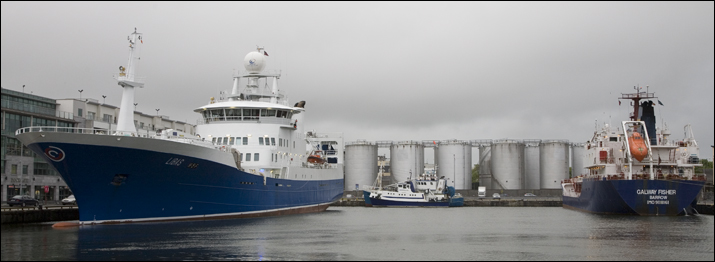
What's big, fishy and sounds Norwegian ? The Libas of Bergen was in port for the last couple of days and it is a behemoth. It's one of Norway's marine research vessel -it's 94 metres long and weighs around 4,000 tonnes, making it about as heavy as most of the oil tankers that dock in the harbour. The ship cost $22 million dollars, with allsorts of gizmos on board, including broadband in every crew cabin (meaning that the crew can keep an eye on their Eurovision hopefuls even if they are sea. Can't joke about Nul points anymore when our own entry plumbs depths that even the sonar of the Libas can't reach).
You can read a fuller description here and here. I had meant to post this yesterday but I spent most of it on a bus (see below). It squeezed out of port this evening (see pic 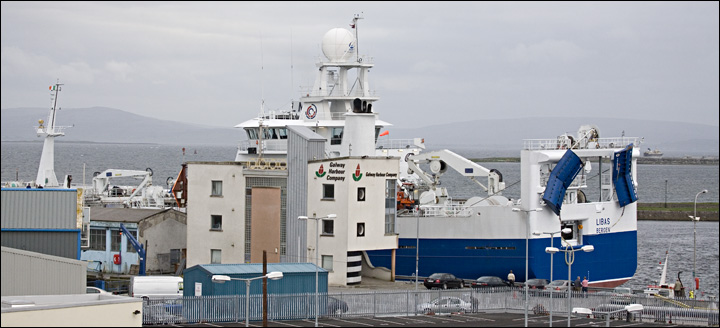 here). There seems to be a lot of big and/or fancy boats in port at the moment. Which was probably why the coastguard was busy doing manoeuvres in the bay this evening - it will probably be another busy summer for them. And not in a good way.
here). There seems to be a lot of big and/or fancy boats in port at the moment. Which was probably why the coastguard was busy doing manoeuvres in the bay this evening - it will probably be another busy summer for them. And not in a good way.
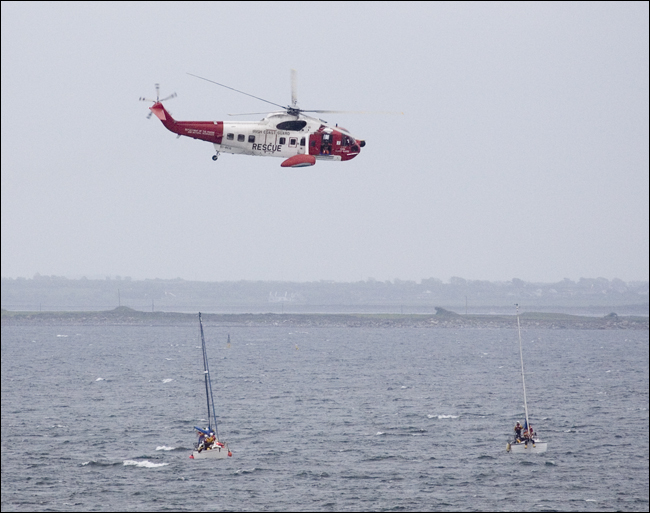
salthill,ireland, irishblogs,photoblogs,monasette,galway,Canon,5D.
Unforgiven
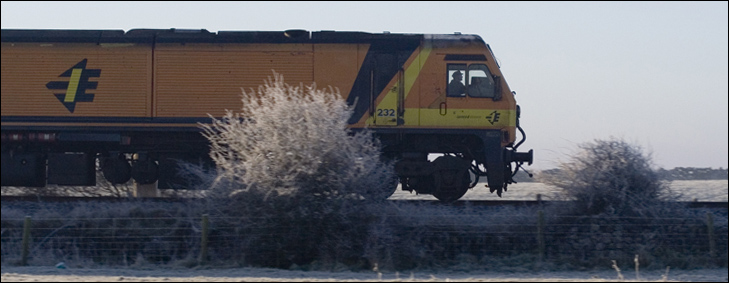
Galway-Dublin train passing through Oranmore on a frosty morning last March - driver doesn't seem to have any problem driving this one.
Julie Feeney was the featured artist this week on John Kelly's radio show. And, appropriately for a show called the Mystery Train, Julie lists the sound of the Galway-to-Dublin train among the credits on her debut album. She'd have been in trouble if she decided to record the album this week. Yesterday morning, two train drivers in Cork decided that they wouldn't drive the shiny new trains brought over by Irish Rail from Spain. As the day progressed, more drivers decided that they wouldn't even drive the not-so-shiny old trains that they happily drove last Friday. By the end of the day, almost the entire rail network was grounded.
Now, as a daily commuter, I'm pretty tolerant of the train service. When, on the coldest day of the year, the morning train left Galway with no heating, I didn't complain (even the windows were frozen shut). I can forgive the odd delay - the other day, my train was delayed with the announcement (in purest Inchicore) that "there was a track delay - and they can be very tricky" [in the same tone that a physicist might announce that time travel is very tricky.] Whatever the validity of their claim [and the Labour Court in January ruled that their grievance relating to the new trains has no validity at all], it is unforgivable to transport people around the country for the weekend, and then not bother bring them home. Funnily enough, train drivers had no problems driving the trains for six months when they were sent to Spain on expenses for testing and training on the new locomotives. Luckily, at my station, the manager had organised a bus back to Galway so I could get home, albeit a bit later than normal.
On the next seat on my train yesterday morning was Niall O Brollcháin, Green party councillor, possibly the next mayor of Galway and maybe even prospective candidate in the next general election. Niall has a vision for Galway (on his website) that includes a second (light) railway system running through the city. I wonder if Niall has got home yet ?
Camera = Canon 350D , lens= Canon 75-300mm@75mm, ISO=400,Aperture=f9,speed=1/500 sec.
train,ireland, irishblogs,photoblogs,monasette,galway,Canon,350D.
May 15, 2006
An bhfuil cead agam dul amach ?

Because Flickr seems to be acting up a bit, I haven't been able to load up a gallery of photos from the surfing in Lahinch on Saturday. So you'll have to do with another testament to flowing water - the public toilets on the promenade in Salthill in Galway, taken while I was hanging around waiting for the lightning to make an appearance last week. At least the photo has the Clare colours.
Camera = Canon 5D , lens= Canon 24-105mm@24mm, ISO=400,Aperture=f11,speed=8 sec.
salthill,ireland, irishblogs,photoblogs,monasette,galway,Canon,5D.
May 13, 2006
Surf's Up
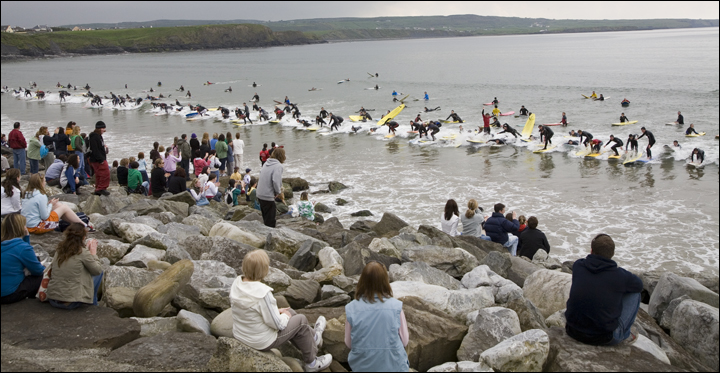
This afternoon in Lahinch, Co.Clare, the world surfing record was broken - i.e. the greatest number of surfers on the same wave. The previous record was 42, and as you can see from the shot above, there's nearly fifty surfers 'hanging ten' on this wave (which was the one declared the record-breaker). Well, it was actually Hector O hEochogain, the garrulous MC of the event, that declared it a record - he was standing beside the nice lady from the Guiness Book of Records roaring into her ear, and I think she would have said anything to get him to stop, well, hectoring her.
I'll post a gallery tomorrow. Now, if this was Hawaii, it would be an excuse to post a set of pics labelled "Hot Chicks in Bikinis" but it's the Atlantic Ocean that laps onto Lahinch's shore (requiring full-body wetsuits), so expect a demure gallery that would pass muster in Iran instead. As for the slack-jawed boyos who sat indoors in Lahinch's pubs gawping at the football; yes, I know it was a good match but surely a world record was worth stirring outside for. As I write this, I suspect that the world drinking record is getting tested in Lahinch and Lisdoonvara - folks, ye deserved it.
UPDATE [21 May 2006]: Lahinch Surf Gallery is finally up.
Camera = Canon 5D , lens= Canon 24-105mm@35mm, ISO=400,Aperture=f8,speed=1/500 sec.
clare,ireland, irishblogs,photoblogs,monasette,lahinch,surf,Canon,5D.
May 12, 2006
Summer Thunder
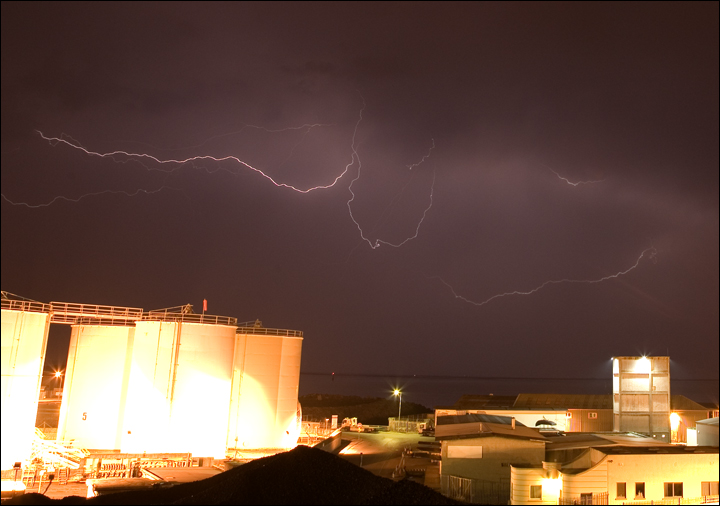
Petrol tanks, a huge pile of coal, and lightning bolts - what could possible go wrong ? Lightning over Galway Bay, photographed from the Docks tonight.
Camera = Canon 5D , lens= Canon 24-105mm@24mm, ISO=100,Aperture=f11,speed=30 sec.
Did anyone else in Galway get a picture of the lightning over the bay this evening ? I had been down on Silver Strand earlier when I heard the thunder rumbling across the bay. I drove back to the Promenade at Salthill and decided to have a look around. It was a beautiful warm, balmy evening and there were loads of people strolling along the seafront. Suddenly, the sky was lit up by streaks of lightning crackling across the sky over the Burren hills across the Bay.
I quickly set up my camera and tripod (or portable lightning conductor, to give it it's full title). Now, if you see a flash of lightning, it's already too late to take a snap. So I pointed the camera in the general area of sky where the lightning occurred, counted the period between flashes, and set off a number of long exposures, in the hope that lightning would appear during the shot. I had even picked a nice colourful foreground (see picture below) - all I need was a bolt from the blue.
It didn't take long. A number of flashes happened during the exposures. But there was a problem - they weren't bright enough to show up in the photographs (except very faintly in two of them) . I took dozens of shots, in the hope that a huge flash would light up the sky. And as time went on, people stopped to ask if I'd got any nice shots, to which I had to mumble,"Err , not yet". There were two huge flashes - I missed the first one because it occurred between shots (after a long exposure, the camera takes a few seconds to write the image to disk) and I missed the second one (and the best) because, five seconds before, my mother rang me on my mobile. OK, I missed both of them.
Thoroughly depressed with the lack of success, I gave up and went home. As I got into the apartment, there was a huge rumble of thunder so I decided to set up both my cameras on the balcony. I set them off on alternating 30 second exposures, so that there was always one of them in mid-exposure. The shot above was the best of it - the field of view wasn't great because of the floodlights and street lamps, but I was too lazy to drive back to Salthill again (and the lightning show only lasted for another 15 minutes after I got home.
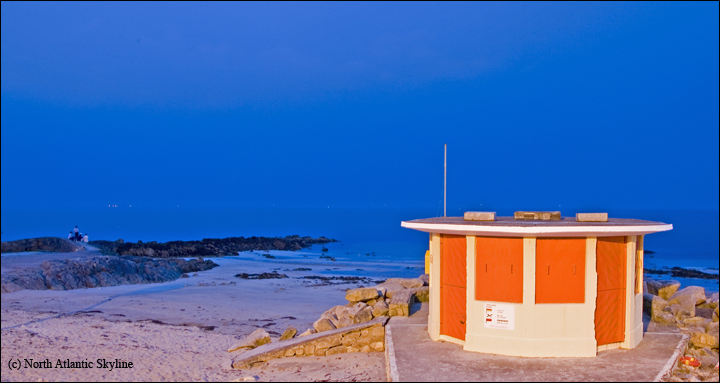
I was very tempted to just Photoshop a few lightning bolts into this picture - Salthill Promenade this evening, as thunder rumbles across the bay.
Camera = Canon 5D , lens= Canon 24-105mm@24mm, ISO=400,Aperture=f11,speed=30 sec.
salthill,ireland, irishblogs,photoblogs,monasette,galway,flower,Canon,5D.
May 09, 2006
The White Stripes
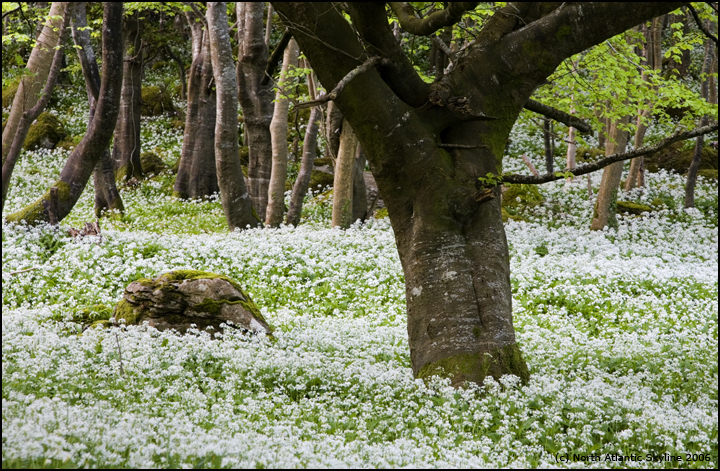
I'm still recovering from minor surgery so I haven't been able to venture beyond the city limits [I can't go hiking or walking but I am just about well enough to go to work. Where's the justice?]. I'm hoping to get to Portumna Forest Park this weekend to photograph the bluebells there but if you're in Galway city, you could do worse than to head out to Menlough, where the wild garlic (ransom) is in full bloom. Photographed this evening (and at almost the same spot as this photo that I took almost exactly a year ago).
Camera = Canon 5D , lens= Canon 24-105mm@105mm, ISO=400,Aperture=f11,speed=1/4 sec.
dandelion,ireland, irishblogs,photoblogs,monasette,monivea,flower,Canon,5D.
May 08, 2006
Summer Rain
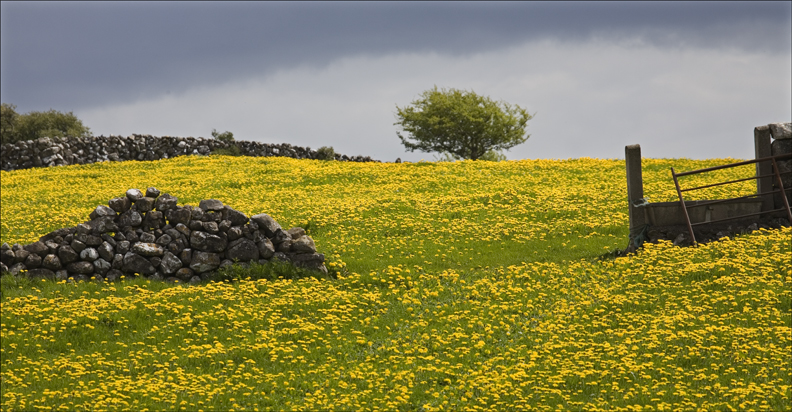
It'll be sunny if it doesn't rain between the showers...The country has exploded into life in the last week. The weather is alternating between blazing sunshine and torrential rain, depending on the hour - I'd settle for the sunshine myself... A field of dandelions near Monivea, Co. Galway (taken yesterday afternoon.)
Camera = Canon 5D , lens= Canon 100-400mm@310mm, ISO=320,Aperture=f11,speed=1/400.
dandelion,ireland, irishblogs,photoblogs,monasette,monivea,flower,Canon,5D.
A Taste of Honey
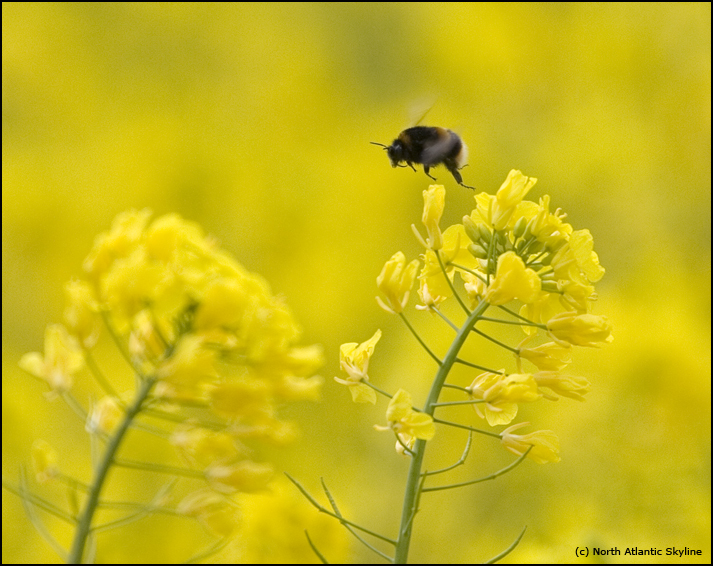
Buff-tailed bumblebee (Bombus terrestris) gathering pollen in a clump of charlock (Sinapis arvensis) this afternoon.
Last year, while on a taxi ride to a train-station, I got chatting to the driver whose hobby was bee-keeping. I mentioned that, having grown up on a farm, I remembered the honeycombs that we would occasionally get from a neighbour who kept bees. Depending on the time of year, the honey tasted of either clover or heather .
The driver knew many more flavours - dandelion honey in late April or early May, Whitethorn a little later and whatever other flowers the bees could get their tongues around. The taxi-man sold all his honey locally - I envied his customers. He didn't blend his honey, so the individual flavours of the pollen came right through in the taste of the honey . He had another interesting observation - the previous year, the flowers produced far less pollen than usual. Sometime later, I Googled for 'pollen failure' or related links and couldn’t find any references. It seemed like no-one had noticed that flowers were producing less pollen than usual. Except the bees and their keeper, of course.
Camera = Canon 5D , lens= Canon 100-400mm@400mm, ISO=400,Aperture=f8,speed=1/1250.
bee,ireland, irishblogs,photoblogs,monasette,Canon,5D.
May 05, 2006
Fallen Angel
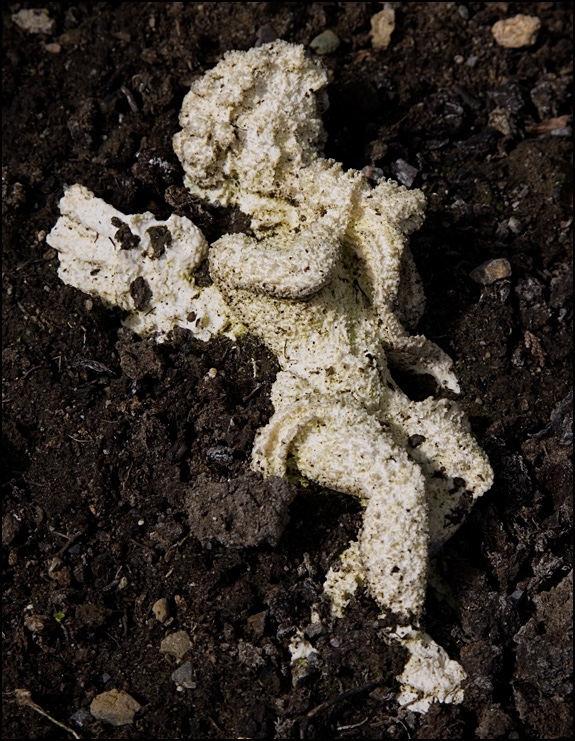
Fallen graveside ornament, Bohermore cemetery, Galway city.
Camera = Canon 5D , lens= Canon 24-105mm@88mm, ISO=400,Aperture=f11,speed=1/800.
galway,ireland, irishblogs,photoblogs,monasette,Canon,5D.
May 03, 2006
Fortune is a River

The Arno flowing through Pisa as Nature, rather than Leonardo, intended. Picture taken at dawn 2 summers ago.
During the two long years of the Eyre Square* redevelopment, some people suggested it should be left unfinished, as a warning to others who might decide to ‘redevelop’ their own town or city. Others predicted that the phrase to do an Eyre Square on it would become a synonym for to make a bollix of something. It’s not the only project under fire in Ireland – the Dublin Port Tunnel, electronic voting, even the Jeannie Johnson all attracted plenty of criticism. None of these projects suffered for want of cash to fund them. You’d think that, given the right people running the project, nothing could go wrong.
Imagine if you got the world’s best engineer ever to design a scheme. Couldn’t fail, could it? And then imagine that you got the most cunning project sponsor in the world to sell the scheme to its stakeholders and oversee its execution. Has to be a sure fire success. Surely?
A little over four hundred years ago in Tuscany, the wealthy cities of Pisa and Florence were at war with each other. The Florentines could see no conventional way of defeating their neighbour. Both cities had access to the Mediterranean via the river Arno – since Florence was upstream, ships had to pay taxes to pass through Pisa. Pisa had also been ruled by Florence (until a French invasion resulted in their independence) so there was that added feeling that the Pisans were just upstarts. Enter Leonardo Da Vinci.
Now Leonardo had many talents – both scientific and artistic. But there were times when he seemed just a couple of double espressos short of madness. Leonardo required rich and powerful noblemen to sponsor his work, and in return, he sometimes developed things that they could use to stay rich and powerful – like weapons. His official role, at the beginning of the sixteenth century was chief engineer to Cesare Borgia – a man who himself had written that his wrath could be dangerous (i.e. fatal) to his subordinates.
The Florentines originally planned to attack Pisa. Well, their actual plan was to hire an army of mercenaries to do the job, but that plan foundered in an argument over money. There was a very real danger that other noblemen might attack Florence itself, sensing that the city could not defend itself [the city had deposed the De Medici family to set up a city republic and it was feared that Borgia would restore their family to power, along with a keenly honed sense of revenge]. Normally, Leonardo would be required to build siege equipment – protected scaffolding to scale walls, or mortars to destroy them. But since the city tradesmen wouldn’t pay the taxes required to fund the battle, another strategy would have to be considered.
He proposed a grand plan. If the Arno were diverted around Pisa, that city would die, or capitulate. But Leonardo wasn’t just thinking about destroying Pisa. If Florence had direct access to the sea, it could become a seaport, with a vastly improved volume of trade. And that trade was not just limited to Europe. In early May, 1501, another Florentine acquaintance of Leonardo, Amerigo Vespucci, had issued a report stating that, based on his scientific calculations and surveys, the new lands discovered in 1492 were not part of Asia, but a new world that would eventually bear his name. And for Florence, [at least in Leonardo's mind]a new world full of commercial opportunities.
But who could persuade the government of Florence, already strapped for cash, to fund such an audacious plan? The Florentine government, the Council of Ten, had a rather skilled politician as their secretary. His name was Niccolo Machiavelli and he liked the plan. On August 20, 1504, the city voted to fund the plan. Leonardo had done time-and-motion studies to calculate the amount of men required to dig the two channels required to divert the Arno, as well as build the weir that would block the existing river path. He calculated that it would require between 30 and 40 thousand man days to dig out the one million tons of earth, creating a ditch a mile long and thirty feet deep, diverting the river from near the Pisa city walls to a swamp (Stagno di Livorno) between the city and the sea [see here for a Google Earth screenshot of the location – the faded area marks the approximate location of the swamp – since drained]. Troops would protect the weir and the trench diggers from the Pisans during construction. Da Vinci also drew up plans for huge digging machines to speed the construction.
There was only one problem – the hydraulic engineer, named Colombino, hired to execute the plan. He didn’t really understand Leonardo’s drawings so he ‘simplified’ the plan. He didn’t bother order the construction of any of the digging machines either, so when the digging fell behind schedule, there was no way to quickly recover the schedule. The plan required the diversion to be dug deeper than the original riverbed. Instead, Colombino’s ‘simplified’ plan meant that the new ditches were too shallow, and the river stayed in its original course. The work on the weir was still under construction when flooding occurred on the Arno. A narrow river flows faster than a wide one and, newly narrowed by the partially constructed weir, the Arno dug itself deeper, rendering the diversions useless. After a storm wrecked some of the project’s defences, and the workers became disheartened, the project was finally abandoned by early October and the Pisans were able to fill in the ditches.
The legacies of Da Vinci and Machiavelli are well known – Colombino is forgotten today. I can’t help thinking that there are plenty of places in Ireland that a statue to him might be appropriate, if only as a warning to others. And the tale should be part of any college course for future project managers, for the same reason. And if the statue of Padraic O Conaire ends up in the new City Museum, there’ll be space in Eyre Square. This story is summarised from a book, called Fortune is a River written by Roger Masters, which I bought in a great little bookshop called BM in Florence two years ago. It’s well worth a read – the Arno diversion is just one chapter but is used as a hook to hang the stories of the lives and work of Da Vinci and Machiavelli. And it will probably be a far better use of your reading time than anything from the Dan Brown oeuvre.
* Spellissey's Book (History of Galway) includes a piece on Eyre Square. Written in 1999, he commented on the then future plans for the Square:-
Plans to redesign Eyre Square are being drafted to mark the millenium and a series of plazas and terraced lawns will replace the now-familiar square. The Georgian Square will be remodelled as planners consider it "underused and a visually-dead urban landscape". The square has altered over the last thirty-five to forty years but it has always possessed a charm of its own. The revamped square will certainly do little for the city as it will resemble too many such places abroad, plazeas that foreign tourists can find in their countries, usually in shopping malls.
May 02, 2006
Ah Shure, don't mind us
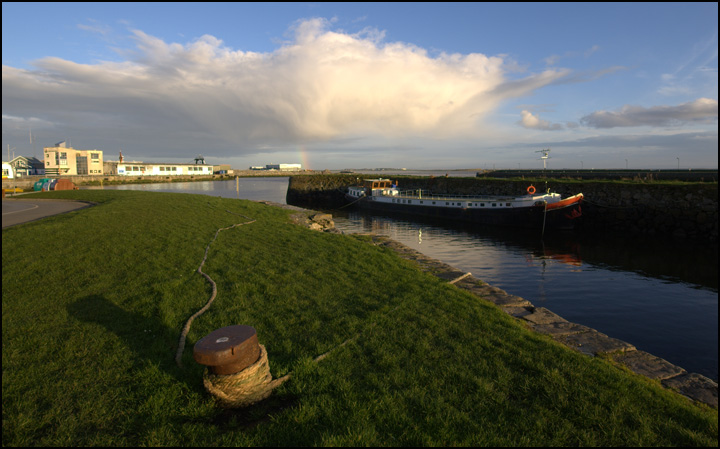
Barge moored in Galway Docks.
Lots of press this week for the Aurélia Oratorio show which opens in the Abbey in Dublin this week - in January, the Irish Times described it as one of the must-see shows of 2006. Hmmm. Had any of the so-called national media bothered to head west last summer, they might have discovered that the show was part of last year's Arts Festival. I suppose the seats are plusher in the Abbey than the Black Box. The show is rather good, by the way [Guardian review here.].
Luckily, help is at hand. Google Earth [my favourite waste of time] have updated their maps of Ireland. Now all the major Irish cities are covered by high-resolution maps, so that even Jackeens might be able to find them. Here are a couple of Galway screenshots - one of the city and a close-up of the docks. Both are already out of date - Eyre Square is now finished, and the Tynagh shed in the docks is gone. You can see a few ships moored in the Docks shot - the naval ship is the L.E. Eithne - it's the only ship with a helicopter pad (the O on the rear deck). The red ship is an oil tanker, the Milford Fisher, unloading fuel [and how sad is it that I've photographed every tanker that came into the docks in the last year]. The boat in the top corner (with a much smaller boat tied up to it) is the Oileann Aran. It remained moored in that same spot (pretty much outside my window) for the entire year that I lived on that side of the building. And within a week or so of my moving , it did too. It sailed to Iceland where it will act as a ferry to an island 30 kms off the Icelandic coast [according to a report in the Galway Independent]. The boat had been tied up since it's Irish owners lost the Aran Island ferry contract at the end of 2004.
galway,google earth,ireland, irishblogs,photoblogs,monasette.
May 01, 2006
May Day

Saturday began as a beautiful day - the start of a great long weekend (ok - it rained yesterday). Sunny and warm, from my balcony, I could see boats sailing across Galway Bay and strollers taking the air along the Claddagh. The Galway Camera club organized a photographic trip to the Mullet Peninsula, so if you're wondering why the paparazzi have descended on North Mayo, now you know. The Galway Walking Club went to Wales to climb Mt. Snowdon and it looks like the weather was kind to them too. Ordinarily, I'd be with either group, but, alas, I'm convalescing and confined to my apartment (amusing myself with You Tube - currently watching the 2 Chinese Boys, the Crazy Surfer and the mishaps of Limerick hill walkers.
No doubt, we'll be treated to a slideshow of the best shots from the Camera Club's trip (Sean already has a picture on his site). The Mullet is a great place to take photos and I've taken some of my own favourite shots there (including these ones : 1, 2, 3, 4, 5, 6, 7 and 8).
And, in keeping with the spirit of things (and I don't mean serving up repeats during the holidays), here's a couple of galleries from last summer that I didn't get around to posting until now - St. Deirbhile's Church and Holy Well. The two sites are at the southern tip of the Mullet Peninsula facing west, near Blacksod lighthouse. In the background of the picture above, you can just about see the islands of Duvillaun Beg and Duvillaun More ( as gaeilge - Dubh Oileán Beag, Dubh Oileán Mór - little black island, big black island). Duvillaun More was sold recently - they were looking for a million) but the other one is still available. both photographed in late afternoon sunshine on January 29th, 2005.
And just a final reminder - if you're going to send me suggestions for Favourite photos, the deadline is lunchtime tomorrow (GMT). Thanks again to Andrea, pj_poppy and Caitriona (who has some pretty cool photos on her own site) for taking the time to get in touch with suggestions. Hopefully, I'll be back on my feet for tomorrow's club meeting.
Camera = Canon G3 digital compact, lens= Canon 7.2-28.8mm@7.2mm, ISO=50,Aperture=f5,speed=1/400.
mayo,belmullet,ireland, irishblogs,photoblogs,monasette,Canon,G3.
